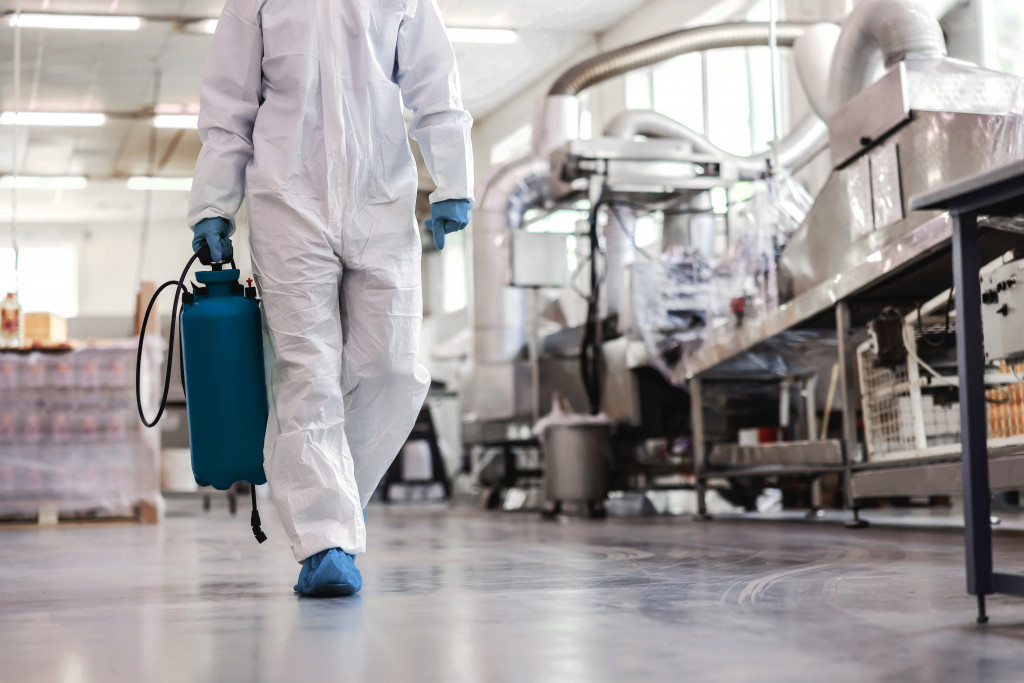- Implement good manufacturing practices (GMPs) to minimize contamination risks.
- Adopt a regular cleaning and sanitization program and train employees on personal hygiene and facility cleanliness to prevent contamination.
- Schedule septic tank maintenance and implement a pest control plan to prevent the spread of disease.
- Have a well-designed ventilation and air filtration system in place for cleaner air.
- Inspect and maintain equipment regularly to prevent malfunctions that could introduce contaminants into production processes.
In today’s fast-paced and competitive world, maintaining a sanitary factory is more important than ever for business owners, entrepreneurs, and company leaders. With the ever-present risks of contamination, it’s crucial to develop and implement a comprehensive cleanliness strategy that encompasses all aspects of your facility. This not only helps ensure the safety and health of your employees and consumers but also contributes to the overall efficiency and functionality of your operations. Here are some tips.
Implementing Good Manufacturing Practices (GMPs):
One of the most fundamental steps in maintaining a sanitary factory is to implement and adhere to good manufacturing practices (GMPs). These industry-standard guidelines outline best practices for everything from personal hygiene to equipment maintenance and are designed to minimize contamination risks. Here are some examples:
Regular Cleaning and Sanitization:
A crucial aspect of maintaining a sanitary factory is the implementation of a regular cleaning and sanitization program. This involves conducting scheduled cleanings of your facility’s floors, walls, ceilings, equipment, and surfaces to ensure that any potential contaminants are removed on a consistent basis.
Additionally, it’s important to use appropriate sanitization agents for your specific industry and to train your employees on the correct usage and handling of these agents to make sure every corner of your factory remains spick and span.
Employee Training and Personal Hygiene:
The role of employees in maintaining a sanitary factory cannot be overstated. Proper training on personal hygiene and facility cleanliness is essential for preventing the spread of contaminants.
This includes instructing employees about the importance of regular hand washing, the use of gloves and other protective gear, and how to properly clean their workstations after use.
Septic Tank Maintenance:
Septic tank maintenance is an important part of keeping a factory sanitary. Ensuring regular septic tank pumping reduces the risk of contamination due to seepage and overflows. Additionally, regularly servicing septic tanks helps identify potential problems before they become major issues.
Pest Control Measures:
Pests, such as rodents and insects, pose a significant contamination risk, as they can spread diseases and cause damage to equipment and products. It is essential to have a robust pest control plan in place, which includes sealing gaps, cracks, and other access points. This also includes setting up traps and scheduling regular inspections and treatments by professionals.

Proper Ventilation and Air Filtration Systems:
Contaminants like dust, bacteria, and airborne particles can have a significant impact on the cleanliness of your factory. To minimize these risks, it is important to have a well-designed and functioning ventilation and air filtration system in place.
This not only helps to maintain a cleaner environment but also promotes a healthier workspace by reducing allergens and pollutants. This is because air filtration systems can remove particles such as dust, pollen, pet dander, and other allergens from the air.
Regular maintenance and inspections of your ventilation and air filtration systems are essential to ensure that they continue to perform effectively and contribute to a sanitary production environment.

Maintaining Sanitary Equipment:
It’s easy to forget, but it’s also vital to regularly inspect and service equipment. This means routinely checking and cleaning all machinery, tools, and other production-related items to make sure they are free from dirt, dust, grease, and other contaminants.
Equipment should also be checked for wear and tear, as any defects can cause malfunctions that could potentially introduce contaminants into the production process. Additionally, it’s important to make sure all safety guards are in place, as these prevent staff from coming into contact with moving parts of machines.
If possible, assign a designated person to inspect and maintain equipment. This helps ensure that all cleanliness protocols are met and reduces the risk of contamination.
By following these tips, businesses can greatly reduce their risk of contamination and create a cleaner, healthier production environment. Implementing good manufacturing practices, regular cleaning and sanitization, employee training, septic tank maintenance, pest control measures, proper ventilation and air filtration systems, and equipment maintenance are all key components of a comprehensive cleanliness strategy. Doing so not only safeguards the safety of your employees and consumers but also helps ensure a smoother running operation.


